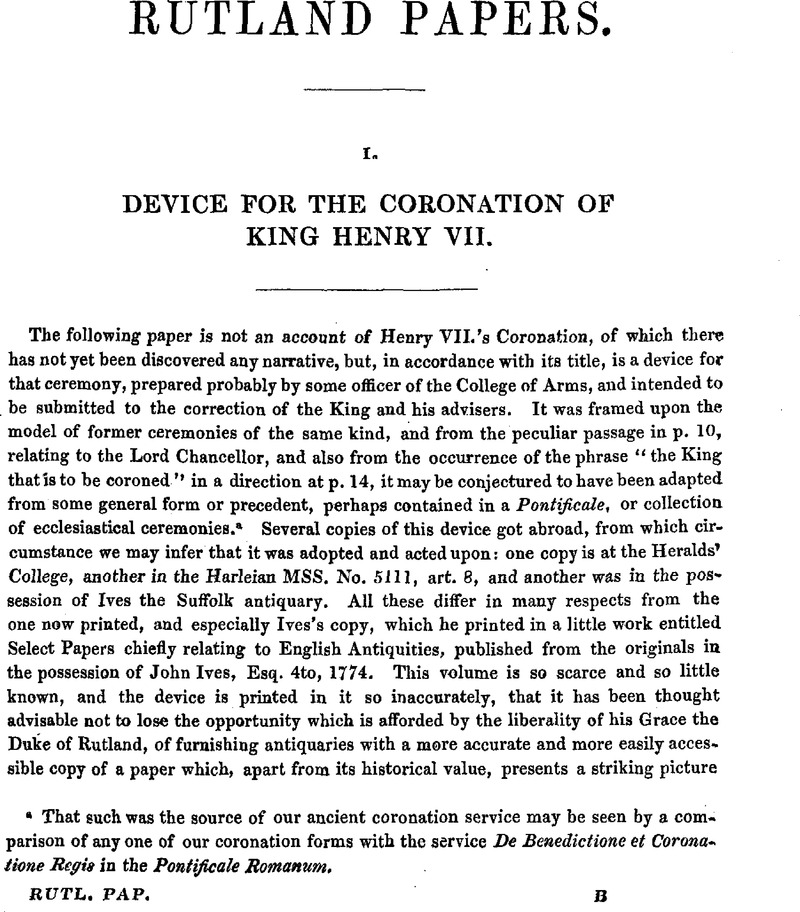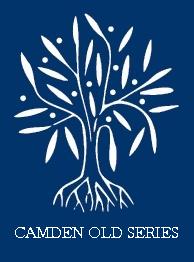No CrossRef data available.
Article contents
I. Device for the Coronation of King Henry VII
Published online by Cambridge University Press: 23 February 2010
Abstract

- Type
- Rutland Papers
- Information
- Copyright
- Copyright © Royal Historical Society 1842
References
page 1 note a That such was the source of our ancient coronation service may be seen by a comparison of any one of our coronation forms with the service De Benedictione et Coronatione Regis in the Pontificale Romanum.
page 2 note a The MS. torn.
page 2 note b viijthMS.
page 2 note c A blank in the MS.
page 3 note a Vide post. p. 5, note c.
page 3 note b John de Vere, Earl of Oxford, was a staunch adherent of the house of Lancaster, and a great promoter of the success of Henry VII. whom he accompanied into England, and aided in the battle of Bosworth. He was attainted in the reign of Edward IV. but upon Henry's accession was not merely restored to his lost honours, but rewarded with many fresh ones. At Henry's Coronation he was one of the Commissioners for executing the office of High Steward (Fœd. xii. 277), and was afterwards appointed Constable of the Tower and Lord High Admiral. He held these offices in addition to that of Lord Great Chamberlain, which was hereditary in his family from the time of Henry I. (Dugd. Baron, i. 197.)
page 3 note c Vide post. p. 5, note a
page 3 note d Sir Edward Stanley, Knight, was a younger son of the Lord Stanley just mentioned. In the next reign he had a command at Flodden, and by winning the mount on that field, greatly contributed to the victory. In commemoration of this service, and in allusion to his crest, which was an eagle, he was created Lord Mounteagle. He was also honoured with the Garter. (Dug. Bar. ii. 254.)
page 3 note e Sir William Hussey was a lawyer, and during the reign of Edward IV. passed through the grades of Attorney General and Serjeant at Law, and was ultimately appointed Lord Chief Justice of the King's Bench. He held the last office until 1496. (Dug. Bar. ii. 309.)
page 3 note f William Lord Berkeley had stood in great favour with Edward IV. and Richard III.; and by the latter sovereign was created Earl of Nottingham, but, upon learning that the Earl of Richmond was about to invade England, he fled to him in Brittany. He was created by Henry VII. Earl Marshal for the day of the coronation, and ultimately had that office granted to him and his heirs male. He was also created Marquess of Nottingham. (Dug. Bar. i. 364.)
page 4 note a make in MS.
page 5 note a Thomas Lord Stanley was created Earl of Derby on the 27th October 1485. This paper must consequently have been prepared between the time when that creation was determined upon and the 30th of the same October, which was the day of the coronation. It will be observed that the same nobleman is mentioned at p. 3, by his title of Lord Stanley. The readers of Shakspere are familiar with the history of his defection from Richard III. on the morning of the battle of Bosworth. Before that battle he had married Margaret, the widow of the Earl of Richmond and mother of Henry VII., a circumstance which made him an object of especial suspicion to Richard. (Dug. Bar. ii. 248.)
page 5 note b This allusion to the Duke of Norfolk, Earl Marshall of England, after it had been already stated at p. 3, that the Earl of Nottingham had been appointed Marshall for the day of the coronation, is a proof that the paper was prepared merely as a device for correction. John Howard, Duke of Norfolk, it is well known, was killed at Bosworth.
page 5 note c Jasper Earl of Pembroke, by which title he is mentioned at p. 3, as one of the Commissioners of the Court of Claims, was created Duke of Bedford on the 27th Oct. 1485. (Dugd. Baron, ii. 242.) The mention of him by his new title is another proof that this paper must have been compiled on the very eve of the coronation.
page 5 note d John de la Pole, Duke of Suffolk, married Elizabeth sister to King Edward IV.
page 7 note a This passage is printed as it stands in the MS. but it is difficult to say who were the persons indicated as “lords Graies Powis.” John Grey was at this time Lord of Powys, or Lord Grey of Powys, for it is doubtful which. If he be thought to be here mentioned as Lord Powis, then the Lord Grey might be Henry de Grey, the last Lord Grey of Codenoure. (Dug. Bar. i. 712, ii. 284.)
page 7 note b her in MS.
page 8 note a of in MS.
page 8 note b Created Baron Daubeney 12th March 1486. He was one of the first persons whom the friends of Henry VII. consulted previous to his invasion of England in opposition to Richard III. (Dug. Bar. i. 117.)
page 9 note a Thomas Bourchier, Cardinal of St. Ciriacus, Archbishop of Canterbury from 1454 to his death in 1486.
page 9 note b Thomas Rotheram, Archbishop of York from 1480 to his death in 1500.
page 9 note c John Esteney, Abbot from 1474 to his death in 1498.
page 10 note a Peter Courtenay, Bishop of Exeter from 1478 to 1487, when he was translated to Winchester.
page 10 note b John Morton, Bishop of Ely from 1478 to 1486, when he was translated to Canterbury. He was also Cardinal of St. Anastasia. He was imprisoned by Richard III. but escaped to the continent and joined the Earl of Richmond. He did not accompany him into England, but was sent for by Henry as soon as he was settled on the throne.
page 10 note c The words placed within brackets seem evidently an interpolation of the writer of the Device. He had before him some general form in which the entry stood thus:— “Next before the King my Lord Chauncelor of England, if he be a Bishoppe, shall bere the patent [paten], and in case he be no Bishoppe, then the Bishoppe of Chicestre to be appoynted in his place by the King.” The transcriber knew that John Alcock, Bishop of Worcester, was the Lord Chancellor, and he sought to adapt the form to the existing circumstances, or at any event to bring the question of the necessary correction under the notice of the persons subject to whose revision he was writing. Dr. Story, the builder of Chichester Cross, then filled the see of that city.
page 11 note a William Fitz Alan, Earl of Arundel, who died in the 3d year of Henry VII.
page 11 note b George Talbot, Earl of Shrewsbury, grandson of the great John Talbot.
page 11 note c Sir Edward Courtenay, the representative of a family not more distinguished for illustrious descent than for its loyalty to the house of Lancaster, was created Earl of Devon on the 26th October, 1485. This is another proof that this paper was prepared within a few days of the coronation.
page 11 note d Henry Bourchier, Earl of Essex, nephew of the Archbishop of Canterbury. The Bourchiers were great supporters of Henry; one of them, Sir John Bourchier, became co-pledge with the Marquis Dorset for money which Henry borrowed at Paris for his English expedition, and was redeemed by Henry shortly after his accession. Stowe's Chron. 471.
page 11 note e and in MS.
page 11 note f Sir Richard Guildford, K.G. father of Sir Henry Guildford, also K.G., both of them often engaged in public services during the reigns of Henry VII. and Henry VIII.
page 11 note g “Maister Savage” was probably the John Savage “an approved Captain,” who contrived to intimate to Henry VII., before he landed in England, that he was ready to aid him, and who subsequently, with the troops under his command, deserted Richard on the eve of the battle of Bosworth. (Hall, 410–413.) He was the ancestor of the Earls of Rivers of that name.
page 11 note h James Goldwell, Bishop of Norwich from 1472 to his death in 1499.
page 12 note a The exclusion of these two prelates was the result of personal prejudice against them as supporters of the late sovereign. John Sherwood, Bishop of Durham, had been Edward IV.'s solicitor of causes at Rome, and had lately been appointed to his Bishopric by Richard III.; Robert Stillington, Bishop of Bath, had been Lord Chancellor in Edward IV.'s time, and had also been much employed by him in negotiations, and especially in one with Flanders, the object of which was to procure the future Henry VII. to be delivered up to Edward. He was also a chief manager in the coronation of Richard III. At a subsequent period of Henry's reign he was accused of treason, and confined in Windsor Castle until his death in 1491. The right of supporting the sovereign in the coronation procession is by prescription appurtenant to the Bishops of Durham and Bath. It will be observed that in this device the Bishop of Exeter is assigned to support both the King and the Queen.
page 12 note b It is singular that any service should have been assigned to Lord Lovell, who had been one of Richard III's greatest friends, and after the battle of Bosworth lived concealed for some months in various parts of England, until he could effect his escape to Flanders, whence he returned with Lambert Simnel, and was killed at the battle of Stoke. The service assigned to him was not appurtenant to any of his lands or titles.
page 12 note c Lord Lisle performed this service at the coronation of Richard III.'s Queen. It does not appear whether he ultimately did so at that of the Queen of Henry VII.
page 13 note a serue in MS.
page 13 note b John Alcock, Bishop of Worcester, and afterwards of Ely, was Lord Chancellor for a short time after Henry VII's accession. See notec, p. 10.
page 14 note a conserue in MS.
page 14 note b the spirituall in MS.
page 14 note c predecessours in MS.
page 16 note a knowe in MS.
page 16 note b done by befor in MS.
page 16 note c Sir Thomas Montgomery, K. G. was one of the Executors of Edward IV. and a distinguished person from the reign of Henry VI. to that of Henry VII. Vide Excerpta Hist. 378, and Wardrobe Accounts of Ed. IV. 251.
page 16 note d There is a blank left here in the MS.
page 16 note e Sir Thomas Borough, of Gainsborough, K.G, created Baron Borough, in the 3d Henry VII. (Dug. Bar. ii. 288.)
page 17 note a Vngerunt in MS.
page 17 note b So ia MS.
page 18 note a Accipite armula in MS.
page 18 note b wodyn in MS.
page 19 note a sanctis in MS.
page 19 note b maed in MS.
page 19 note c ligemen in MS.
page 21 note a gon in MS.
page 21 note b and to the in MS.
page 22 note a hym in MS.
page 22 note b her in MS.
page 22 note c thatt in MS.
page 23 note a he as the said in MS.
page 23 note b and in MS.
page 24 note a her in MS.
page 24 note b sustaining in MS.
page 24 note c by in MS.


